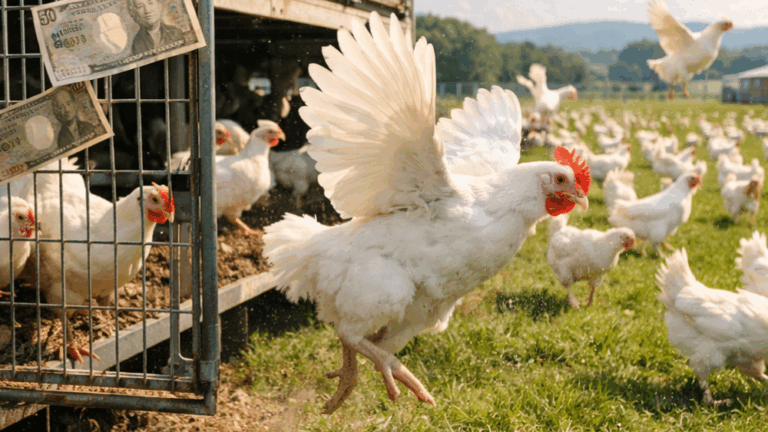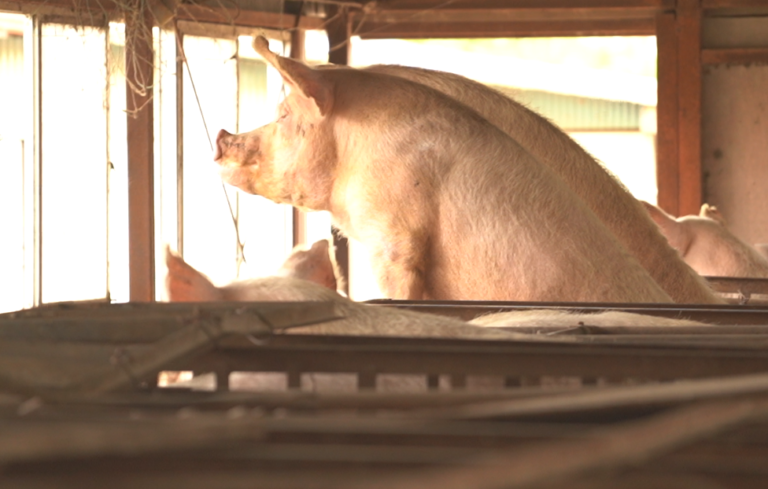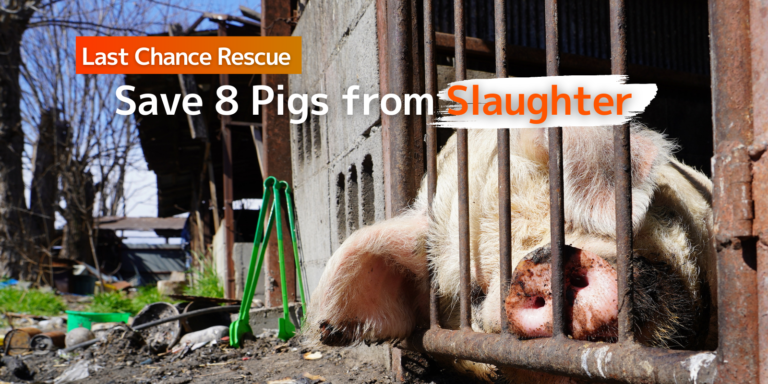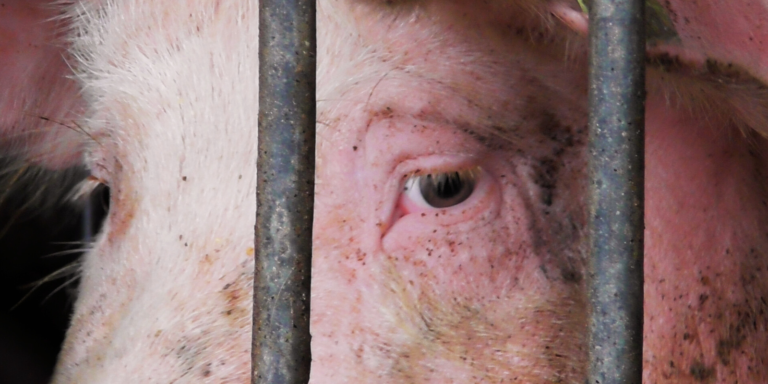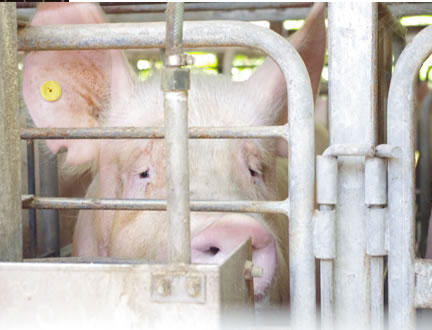
Breeding sows are impregnated (through artificial insemination or copulation with boars) about 8 months after their birth. After impregnation, each sow is placed into a gestation crate (also known as a sow stall) – A metal crate or cage with a bare slatted floor. Is so narrow that she can’t even turn around or stretch. She stays in this crate for the whole of the gestational period (115 days). Shortly before giving birth, she is moved into a farrowing crate. A farrowing crate (or, stall) is similar to a gestation crate but with bars at the sides thorough which the newborn piglets (who are kept in a small enclosure, next door,) nurse. After 21 days, the piglets are taken away, and the mother pig is placed into a stall with several other sows. She stays here for 5-7 days until her next impregnation, and the cycle begins again.
The natural lifespan of a pig is 15 years, but breeding sows are forced to give birth 2 or 3 times a year and then killed at the age of 4 or 5.
Meat from these female pigs, who have given birth many times, is ranked as “off-grade” and is traded at a low price. It isn’t usually sold at meat counters in supermarkets, but ends up as “pork” in processed foods and flavorings. It is estimated that 9,643,000 breeding sows are being forced to live in these conditions in Japan. (2013 by Ministry of Agriculture, Forestry and Fisheries of Japan statistics).
Use of Gestation Crates in Japan
Gestational crates are used on 83% of pig farms in Japan. This is simply because their use makes it more convenient for farm operators to manage impregnation, miscarriage and feeding (2007 Livestock Technology Association Statistics).
Pigs are extremely intelligent animals, considered by many animal behaviorists to be smarter than 3-year old children. They are also highly social and under normal circumstances sows live in small maternal groups consisting of 3 to 4 sows and their offspring. However, breeding sows on these factory farms, spend almost their entire lives alone, confined to tiny, bare enclosures, (which measure around 1㎡,) unable to express any of their natural social behaviors.
Their suffering
In natural conditions, a sow is very active during the gestational period and will withdraw in order to create a safe, elaborate nest using branches and grass before delivery.
This instinctive behavior remains unaltered no matter what conditions a pig is kept under. Breeding sows, confined to small gestation crates, also become very active and spend many hours everyday, in trying to perform this nest building behavior, often injuring themselves terribly, in hopeless attempts to root and dig a hollow for a nest, in their concrete stalls.
It is also well documented that when pigs are confined to small enclosures, and are unable to build nests, turn around, or establish communication with other pigs, they show many abnormal behaviors, indicative of severe frustration and stress, such as sham-chewing (continuing to move their mouths even when they don’t have food or water,) or gnawing the bars in front of them.
Almost all the suppliers of pig meat and products, sold in supermarkets, used in family restaurants, convenience stores, and fast-food chains in Japan, confine female pigs to gestational crates and farrowing crates.
The use of these stalls is typical of factory farming, which values high productivity over even the most basic animal welfare.
Overseas abolition movements against gestation crates ( sow stalls).
Laws banning the use of sow stalls are being introduced rapidly.
Since January 1st 2013, sow stalls have been banned across the EU (except for the period from weaning of the previous litter, until the end of the first 4 weeks of gestation). (In Switzerland, Sweden and Norway the use of farrowing crates is also prohibited.)
In the USA
The use of stalls was banned in California (2014), Florida (2008), Maine (2011), Rhode Island (2013), Oregon (2013), and Arizona (2013).
The use of stalls will be banned in Colorado by 2018, Michigan 2020, and Ohio 2025.
In June 2014, one of the largest grain companies, Cargill, Inc, announced that it would ban the use of stalls both in its own farms by year-end 2015 and in contract farms by 2017.
New Zealand
The use of stalls will be phased out by 2015.
Australia
The use of stalls will be phased out by 2017.
Canada
The ban on the use of stalls has been discussed by the Assembly and is close at hand.
In March 2014, the National Farm Animal Care Council in Canada announced new standards for the breeding of pigs. Facilities for breeding pigs, built after July 1st 2014 have to be adapted for group breeding.
What you can do:
The best choice is not to eat meat. A plant-based diet can provide for all of your nutritional needs. In fact, it is the position of the ADA (American Dietetic Association) that “appropriately planned vegetarian diets, including total vegetarian or vegan diets, are healthful, nutritionally adequate, and may provide health benefits in the prevention and treatment of certain diseases”. This is a position that is now internationally accepted.
If it is difficult to give up meat completely, you can try a “meat-free day” once a week. Meat-free days are becoming increasingly popular in cities and schools all around the world.
Another choice you can make is to only purchase meat products from producers who don’t use gestation crates (sow stalls). Some companies such as Radish Boya, Boo Hoo Woo Farm, and Eco Farm in Kagoshima prefecture, don’t deal in pork from facilities that use sow stalls.
These kinder choices can lead to a significant reduction in the suffering of animals.




